At CoCreative Interiors, we ADORE a good throw pillow! Throw pillows are an easy way to bring pops of color and patterns into your living space, and they add a level of comfort and coziness to any room. With so many options, there are many ways to add throw pillows to your home. Need a few good tips for choosing the best throw pillows for your space and where to place them? Keep reading!
How to Choose the Right Decorative Pillows
Not all throw pillows are created equal. From the shape and material to the insert, there are many ways to customize your pillows for longevity and matching the style of your home.
Throw Pillow Size & Shape
Square: A square throw pillow is the most common shape you can find. They are usually 16, 18 or 20 inches. Since they are a standard size, finding a variety of inserts is easy. If you like to change your pillow covers with the season, sticking with square pillows makes doing so easy/ You can switch out the pillows without purchasing new inserts.
Round: Round pillows are less common but are a nice contrast to the straight lines of a square pillow.
Bolster: A bolster pillow is cylinder-shaped and is named for its use. A bolster is intended to prop up your arms or back. They are usually found on a bed but can also be used in other living spaces. Lumbar: The lumbar pillow was initially created to provide back support. They are long and rectangular in shape and are primarily decorative. They are often used as the top layer of pillows on a bed, sofa or armchair.
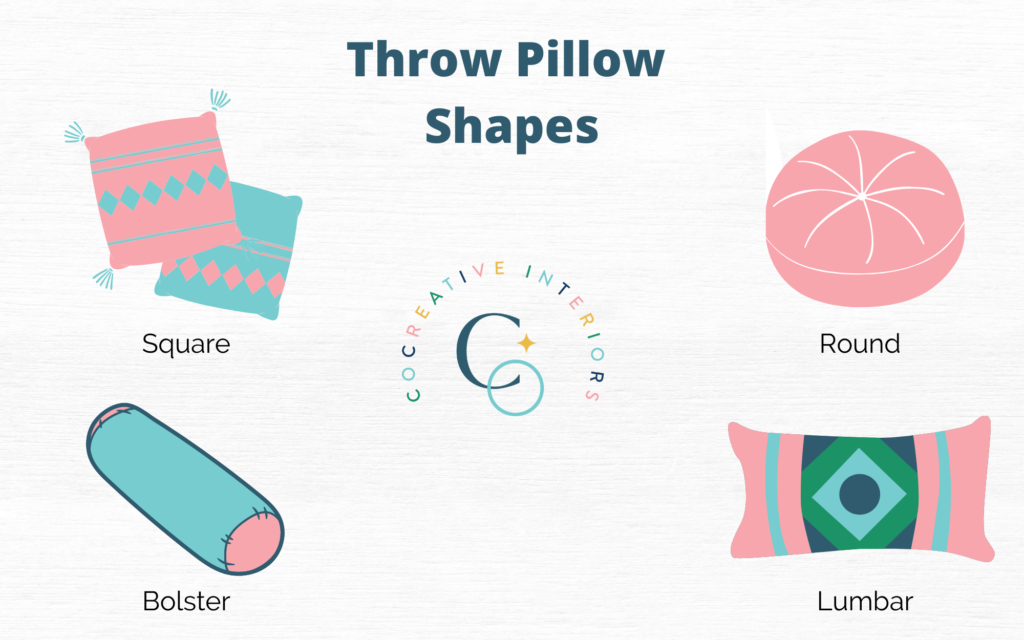
Throw Pillow Fills & Inserts
A variety of materials are used in pillow inserts. We recommend choosing the insert and fill material based on how the pillow will be used.
Polyester: Polyester is a synthetic and the most cost-effective fill option. Synthetic polyester can be a good choice for primarily decorative pillows. Make sure the material is tightly packed to avoid a droopy, caved-in look when choosing an insert.
Down: Down pillows are soft and last longer than polyester. They are also more expensive. This material is excellent for pillows that will get a lot of use in your home. Down will be more comfortable and is easily fluffed back into shape. If you want the classic, karate-chopped look, down inserts are the only way to go.
Foam: Foam is typically used in bolsters and round throw pillows as it holds its shape well. You can use it in a square pillow, but it will not have the softness of down or polyester.
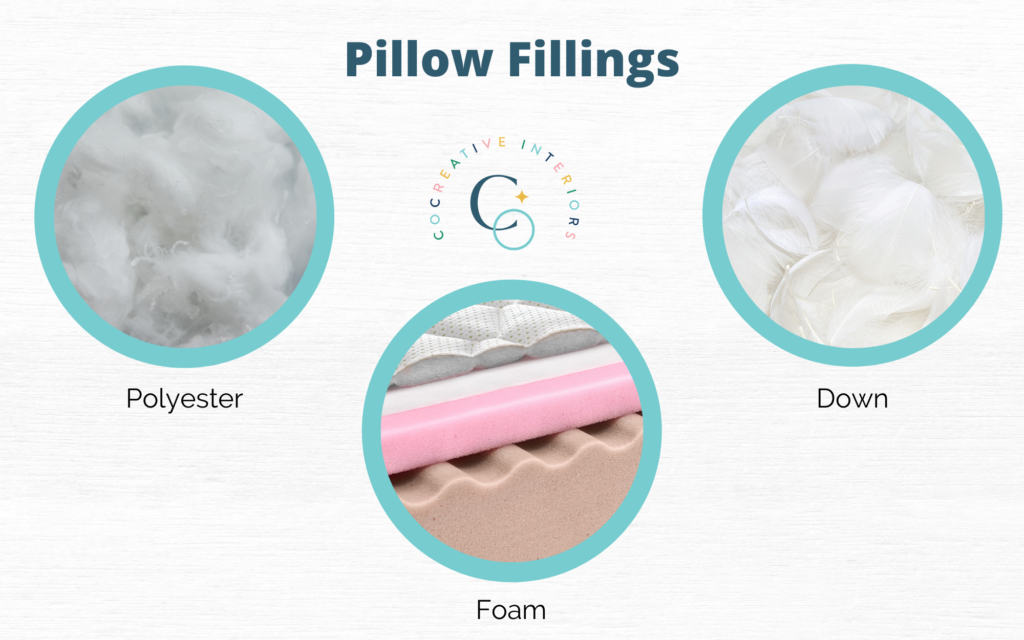
Pillow Styles
Knife Edge: A knife-edge pillow is the cleanest and most simple throw pillow. There are no embellishments or detailing on the edges; the fabric is sewn together along the edges. Knife-edge pillows are the most cost-effective due to their simplicity.
Welting: A welt is a thin cord covered in fabric that adds a decorative ridge around the pillow. Welting creates a more tailored and finished look. Two types of welts are self and contrast.
- Self-welting is created using the same fabric as the pillow.
- Contrast welts use a different material from the pillow to create contrast.
Flanges: A flange is a piece of fabric that extends beyond the seam of the pillow. It can be ruffled or straight and adds a bit of visual interest to the throw pillow. There are a variety of flange styles to choose from:
- A split flange is two separate pieces of fabric extending beyond the pillow’s seam. This creates more volume and can be made with the same material or different material for more contrast.
- A butterfly flange is a flange pleat at the corner of the pillow, also called a Turkish corner.
- A ruffled flange creates ruching and is the most feminine look for the throw pillows.
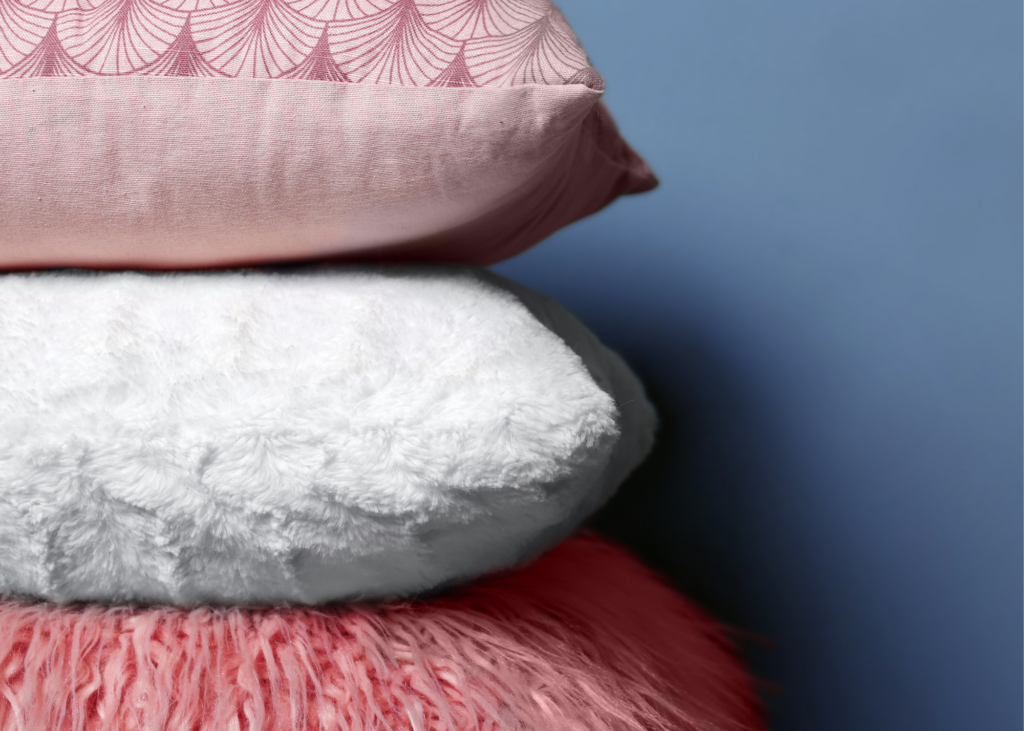
Throw Pillow Embellishments
Throw pillow embellishments add extra decorative elements to pillows. Embellishments can be simple decorative tape or a luxe tassel. Embellishments can add more visual interest and enhance the design no matter your taste. Some of the most popular embellishments:
Tape: A decorative strip of material sewn onto the pillow to elevate the design. Tape can really be applied anywhere on the pillow.
Fringes: Fringe is a trim that adds ornate detail when applied to the edge of the pillow. Trim comes in a variety of textures to suit your aesthetic. There are three main styles of fringe trim that are often used to add texture to throw pillows.
- Brush fringe is a technique that applies simple strands of fabric that hang off the pillow.
- Tasseled fringe is trim that attaches individual tassels around the edge of the pillow.
- Pom pom fringe features fabric balls, or pom poms, that hang off the pillow.
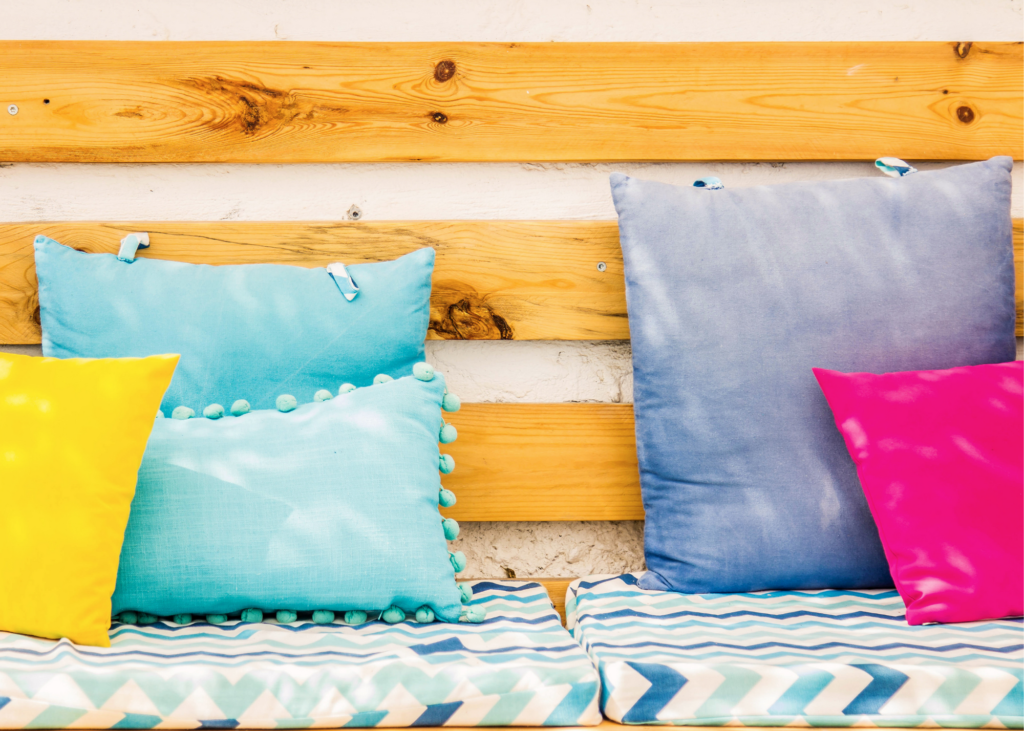
Throw Pillow Fabric
Throw pillow covers can be found in almost every style of fabric. Some fabrics are more durable than others, so choose the right material for how the pillows will be used in your home.
- Cotton: Cotton is durable, easy to wash, and casual; ideal for homes with young children or pets.
- Velvet: Velvet brings instant warmth and coziness to any room.
- Linen: Linen pillows are low maintenance, similar to cotton. Linen is light and airy and is perfect for summer. Bonus, linen is naturally more stain-resistant than other natural fibers.

Throw Pillow Prints & Colors
Choosing prints and colors for your space is often where people start to question what to do. With so many options, our clients often find themselves overwhelmed and afraid of making a mistake. Because they are so easy to change, throw pillows are a perfect place to experiment with bright colors and prints.
Mix and match prints: Mixing prints creates an elevated, layered design. The best way to create a cohesive look is to start with a color palette that carries through all the prints.
Create scale: When choosing your fabrics, pay attention to the scale of your chosen prints. If the main pillows on your sofa are made of a large-scale print, then your drapes will likely work best with a smaller print. This contrast allows you to mix patterns without overwhelming the eye.
Use surrounding colors: When you bring anything into a room, make sure it compliments the colors already in the room. By using the room’s existing color palette, you can easily incorporate new prints into a space.
Add solids and neutrals: You can give the eye a resting place by adding solids and neutrals among bright colors and prints.

Throw Pillow Placement
Before buying pillows, figure out how many you need and the sizes. There are many ways to arrange pillows on your sofa, so figuring out how you want to layer them will help you purchase the right amount of throw pillows. Use the handy charts shared below to determine how many pillows you need.
Sofa Quantity and Layering
Regular Sofa Measurements
Sofa: 72-89″
Square Pillow Sizes: 20×20 and 22×22
Lumbar Pillow Sizes: 11″-14″ Height x 19″ – 20″ Width
On a regular-size sofa, you can create 1-3 layers. A single layer is clean and simple, while multiple layers allow you to mix patterns, textures and colors.
One Layer
- Single Layer: (2) 22″ squares
Two Layers
- Layer #1: (2) 22″ square pillows
- Layer #2: (2) 20″ square pillows or one lumbar pillow
Three Layers
- Layer #1: (2) 22″ square pillows
- Layer #2: (2) 20″ square pillows
- Layer #3: (1) 20″ square pillows or one lumbar pillow
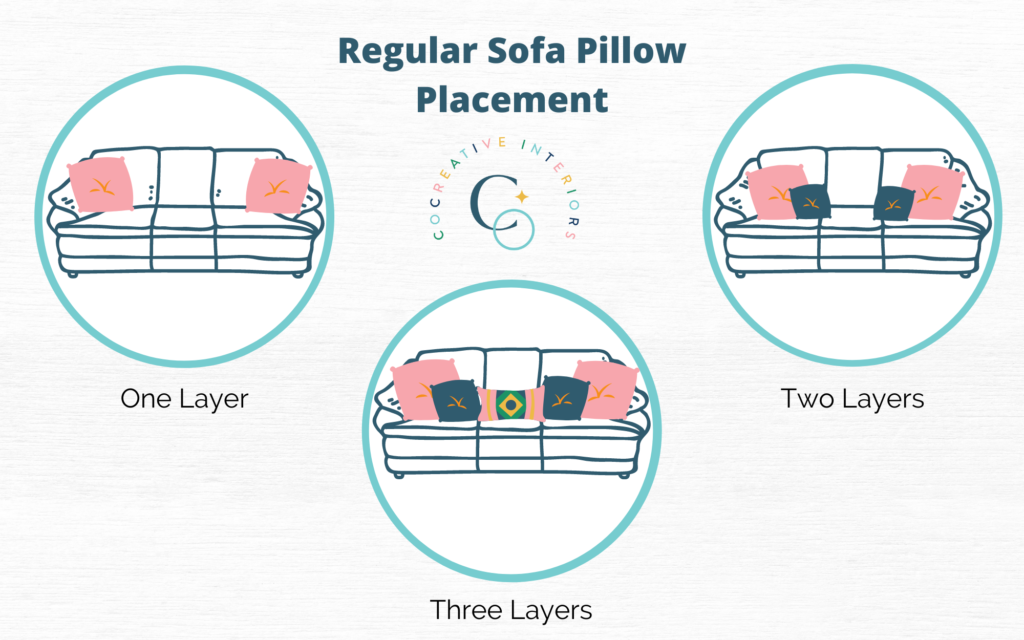
Small Sofa Pillow Placement
Sofa: Less than 72 inches wide
Square Pillow Sizes: 17″ square – 20″ square
Lumbar Pillow Sizes: 10″ – 13″ Height x 17″ – 19″ Width
Quantity and Layering
One or two layers work best on a small sofa. You can play with patterns and colors without overwhelming your small sofa.
One Layer
- Two 20″ square pillows
Two Layer
- Layer #1: (2) 20″ or 18″ square pillows
- Layer #2: (2) 18″ square pillows or one lumbar pillow
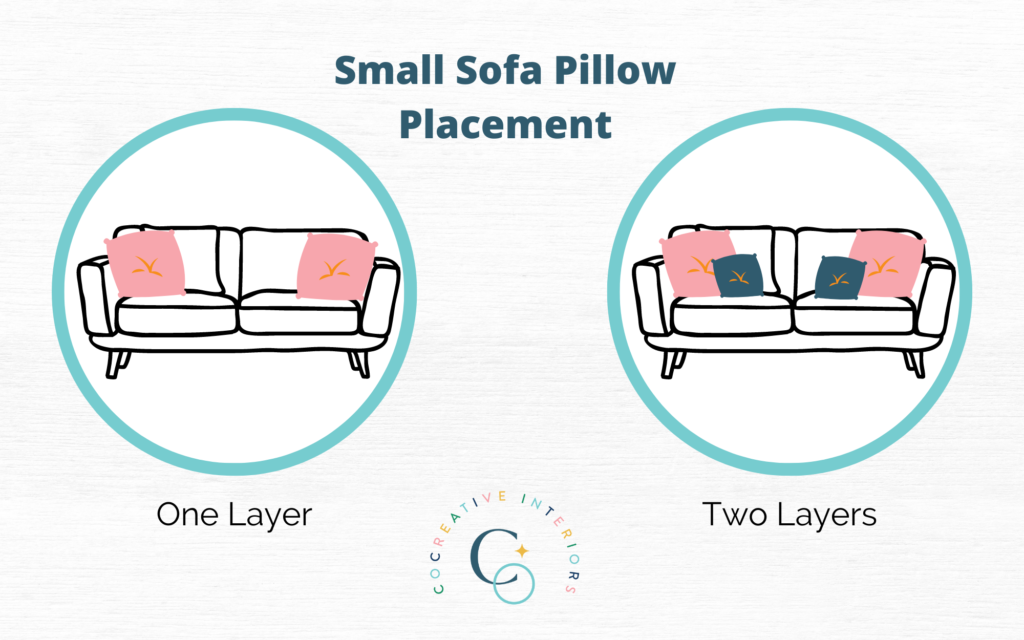
Long and Deep Sofas
Deep sofas have a seat depth of 26″ or more
Long sofas measure 90 inches wide or more
Square Pillow Sizes: 20″ – 24″
Lumbar Pillow Sizes: 13″ – 15″ Height x 20″ – 22″ Width
Quantity and Layering
A long or deep sofa gives lots of space for pillows, so you can add up to four layers. Play with color and pattern freely!
One Layer
- (2) 24″ square pillows
Two Layers
- Layer #1: (2) 24″ square pillows
- Layer #2: (2) 22″ square pillows or one lumbar pillow
Three Layers
- Layer #1: (2) 24″ square pillows
- Layer #2: (2) 22″ square pillows
- Layer #3: (2) 20″ square pillows or one lumbar pillow)
Four Layer
- Layer #1: (2) 24″ square pillows
- Layer #2: (2) 22″ square pillows
- Layer #3: (2) 22″ or 20″ square pillows
- Layer #4: (2) 20″ square pillows or one lumbar pillow

Sectional Sofas
Sectionals vary in size, but you can usually add up to three layers of pillows based on the dimensions.
Square Pillow Sizes: 18″ – 22″
Lumbar Pillow Sizes: 11″ – 15″ Height x 19″ – 21″ Width
Quantity and Layering
One Layer
- 22″ square pillow on each corner
Two Layers
- Layer #1: 22″ square pillow on each corner
- Layer #2: 20″ square pillow on each corner
Three Layers
- Layer #1: 22″ square pillow on each corner
- Layer #2: 20″ square pillow on each corner
- Layer #3: 20″ square pillow on each corner or an 18″x18″ on each end and a lumbar in the middle
Throw pillows are a fun way to add color, texture, and pattern. They are also the easiest thing to change with the seasons, so you can update your home in an afternoon with some new throw pillow covers. If you are interested in adding color and texture to your home but aren’t quite sure where to start, book your complimentary discovery call today! You can also download our free project planner to start any interior design project you might be dreaming about. We love to help our Charlotte, NC clients with all the details of their home design.

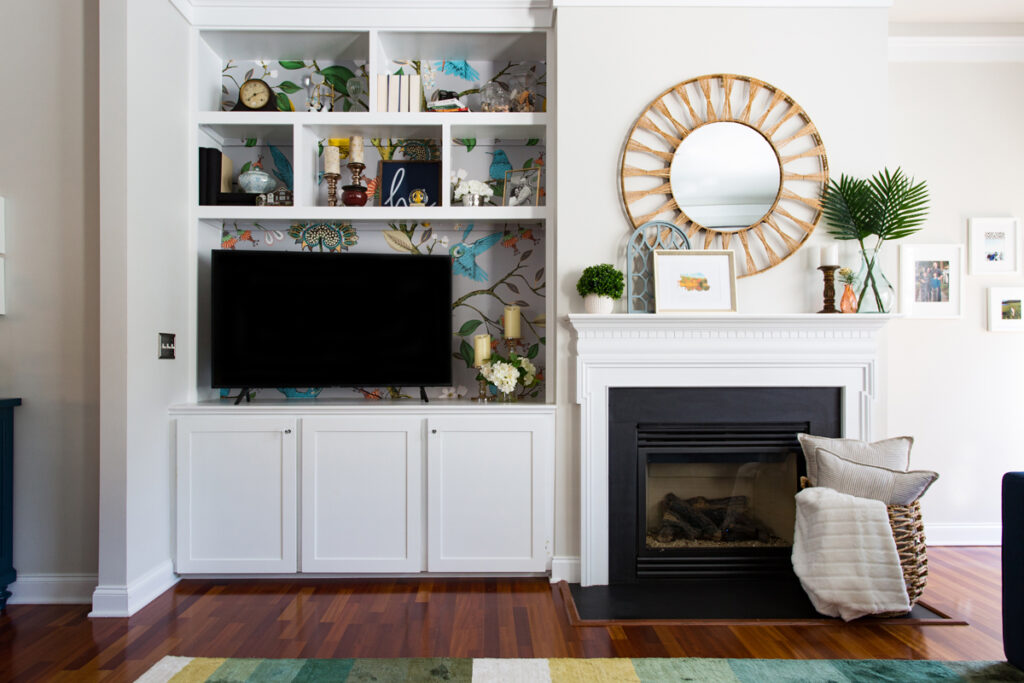



0 Comments